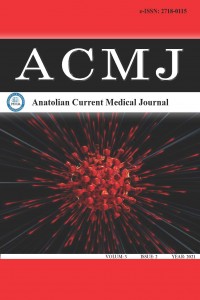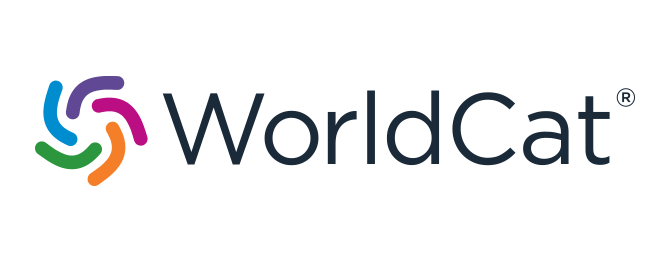Abstract
References
- Şahin S, Akçiçek F. Yaşlı hastada bası yaraları önleme, tanı ve tedavisi. Akademik Geriatri Derg 2009: 1308-5115.
- Altunel CT, Kartal SP. Dekübit ve bası ülserleri. Akgül A, editör. Gerontolojik/65+ Deri ve Sorunları. 1. Baskı. Ankara: Türkiye Klinikleri; 2019. p.87-94.
- Braga IA, Pirett CC, Ribas RM, Gontijo Filho PP, Diogo Filho A. Bacterial colonization of pressure ulcers: assessment of risk for bloodstream infection and impact on patient outcomes. J Hosp Infect. 2013;83(4):314-320.
- Yürüyen M, Özbaş Tevetoğlu I, Tekmen Y, Polat Ö, Arslan İ, Okuturlar Y. Prognostic factors and clinical features in palliative care patients. Konuralp Tip Derg 2018; 10: 74-80.
- George-Saintilus E, Tommasulo B, Cal CE, et al. Pressure ulcer PUSH score and traditional nursing assessment in nursing home residents: do they correlate? J Am Med Dir Assoc 2009; 10: 141-4.
- Bryan CS, Dew CE, Reynolds KL. Bacteremia associated with decubitus ulcers. Arch Intern Med 1983; 143: 2093-5.
- Galpin JE, Chow AW, Bayer AS, Guze LB. Sepsis associated with decubitus ulcers. Am J Med 1976; 61: 346-50.
- Espejo E, Andrés M, Borrallo RM, et al. Bacteremia associated with pressure ulcers: a prospective cohort study. Eur J Clin Microbiol Infect Dis 2018; 37: 969-75.
- Dolynchuk K, Keast D, Campbell K, et al. Best practices for the prevention and treatment of pressure ulcers. Ostomy Wound Manage 2000; 46: 38-54.
- Haesler E. National pressure ulcer advisory panel, European pressure ulcer advisory panel and pan pacific pressure injury alliance. Prevention and treatment of pressure ulcers: quick reference guide 2014: 14-32.
- Dündar D, Özcan SK, Atmaca E. The microbiological investigation of superficial colonization on pressure ulcers of patients managed by home care service. Kocatepe Med J 2012; 13: 1-6.
- Livesley NJ, Chow AW. Infected pressure ulcers in elderly individuals. Clin Infect Dis 2002; 35: 1390-6.
- Robson MC, Mannari RJ, Smith PD, Payne WG. Maintenance of wound bacterial balance. Am J Surg 1999; 178: 399-402.
- Drinka P, Bonham P, Crnich CJ. Swab culture of purulent skin infection to detect infection or colonization with antibiotic-resistant bacteria. J Am Med Dir Assoc 2012; 13: 75-9.
- Ozturk İ, Öztin H. The distribution of agents and antibiotic resistance in decubitus ulcer infection. Med J Mugla Sitki Kocman University 2020; 7: 1-5.
- Bluestein, D. and A. Javaheri, Pressure ulcers: prevention, evaluation, and management. Am Fam Physician 2008; 78: 1186-94.
- Demirel M, Özerk Demiralp C, Yormuk E. Clinic experiences for pressure sores: years between 2000 and 2005. J Ankara University Faculty of Medicine 2007; 60: 81-7.
- Peromet M, Labbe M, Yourassowsky E, Schoutens E. Anaerobic bacteria isolated from decubitus ulcers. Infection 1973; 1: 205-7.
- Dana AN, Bauman WA. Bacteriology of pressure ulcers in individuals with spinal cord injury: What we know and what we should know. J Spinal Cord Med 2015; 38: 147-60.
- Yahav D, Eliakim-Raz N, Leibovici L, Paul M. Bloodstream infections in older patients. Virulence 2016; 7: 341-52.
Abstract
Introduction: Pressure ulcers are a significant cause of morbidity and mortality, and a source of considerable expense in health expenditures. Bacteremia is a frequently seen complication of pressure ulcers, although its incidence has yet to be well defined, and there are scarce studies on the subject. The aim in the present study is to assess the frequency of bacteremia of pressure ulcer origin as an indicator in decisions to start systemic antibiotics in patients with pressure ulcers.
Material and metods: Included in the study were all patients over the age of 18 years receiving palliative care in hospital, and with a pressure ulcer. Pressure wound samples of the patients were taken within the first 24 hours of admission to the hospital. All pressure wounds were washed with sterile saline and a sample was taken using a sterile cotton swab from the deepest and the most solid part of the wounds. we included 76 patients whose 40 (52.6%) were male and 36 (47.4%) were female, with a mean age of 70.8±15.6 (18-95) years. Among the 76 patients, 75 (65.2%) had pressure ulcer infections at 115 different sites of the body.
Result: The rate of bacteremia in pressure ulcers was 13.9% (16/115) , and the agents were found to be polymicrobial in the wound cultures of 42 (55.2%) of the patients. The most common accompanying bacteria were Acinetobacter, Pseudomonas aeruginosa and E.coli. Among the pressure ulcers, 49 (42.6%), 60 (52.4%) and 6 (5.2%) were evaluated as stage 4, 3 and 2 pressure ulcers, respectively.
Conclusion: The causative agent of pressure infections was found to be the agent causing bacteremia in 13.9% of the patients with pressure ulcers in the present study. The agent growing in the wound culture was rarely found to be the causative agent of bacteremia when deciding whether to treat pressure ulcer infections
Keywords
References
- Şahin S, Akçiçek F. Yaşlı hastada bası yaraları önleme, tanı ve tedavisi. Akademik Geriatri Derg 2009: 1308-5115.
- Altunel CT, Kartal SP. Dekübit ve bası ülserleri. Akgül A, editör. Gerontolojik/65+ Deri ve Sorunları. 1. Baskı. Ankara: Türkiye Klinikleri; 2019. p.87-94.
- Braga IA, Pirett CC, Ribas RM, Gontijo Filho PP, Diogo Filho A. Bacterial colonization of pressure ulcers: assessment of risk for bloodstream infection and impact on patient outcomes. J Hosp Infect. 2013;83(4):314-320.
- Yürüyen M, Özbaş Tevetoğlu I, Tekmen Y, Polat Ö, Arslan İ, Okuturlar Y. Prognostic factors and clinical features in palliative care patients. Konuralp Tip Derg 2018; 10: 74-80.
- George-Saintilus E, Tommasulo B, Cal CE, et al. Pressure ulcer PUSH score and traditional nursing assessment in nursing home residents: do they correlate? J Am Med Dir Assoc 2009; 10: 141-4.
- Bryan CS, Dew CE, Reynolds KL. Bacteremia associated with decubitus ulcers. Arch Intern Med 1983; 143: 2093-5.
- Galpin JE, Chow AW, Bayer AS, Guze LB. Sepsis associated with decubitus ulcers. Am J Med 1976; 61: 346-50.
- Espejo E, Andrés M, Borrallo RM, et al. Bacteremia associated with pressure ulcers: a prospective cohort study. Eur J Clin Microbiol Infect Dis 2018; 37: 969-75.
- Dolynchuk K, Keast D, Campbell K, et al. Best practices for the prevention and treatment of pressure ulcers. Ostomy Wound Manage 2000; 46: 38-54.
- Haesler E. National pressure ulcer advisory panel, European pressure ulcer advisory panel and pan pacific pressure injury alliance. Prevention and treatment of pressure ulcers: quick reference guide 2014: 14-32.
- Dündar D, Özcan SK, Atmaca E. The microbiological investigation of superficial colonization on pressure ulcers of patients managed by home care service. Kocatepe Med J 2012; 13: 1-6.
- Livesley NJ, Chow AW. Infected pressure ulcers in elderly individuals. Clin Infect Dis 2002; 35: 1390-6.
- Robson MC, Mannari RJ, Smith PD, Payne WG. Maintenance of wound bacterial balance. Am J Surg 1999; 178: 399-402.
- Drinka P, Bonham P, Crnich CJ. Swab culture of purulent skin infection to detect infection or colonization with antibiotic-resistant bacteria. J Am Med Dir Assoc 2012; 13: 75-9.
- Ozturk İ, Öztin H. The distribution of agents and antibiotic resistance in decubitus ulcer infection. Med J Mugla Sitki Kocman University 2020; 7: 1-5.
- Bluestein, D. and A. Javaheri, Pressure ulcers: prevention, evaluation, and management. Am Fam Physician 2008; 78: 1186-94.
- Demirel M, Özerk Demiralp C, Yormuk E. Clinic experiences for pressure sores: years between 2000 and 2005. J Ankara University Faculty of Medicine 2007; 60: 81-7.
- Peromet M, Labbe M, Yourassowsky E, Schoutens E. Anaerobic bacteria isolated from decubitus ulcers. Infection 1973; 1: 205-7.
- Dana AN, Bauman WA. Bacteriology of pressure ulcers in individuals with spinal cord injury: What we know and what we should know. J Spinal Cord Med 2015; 38: 147-60.
- Yahav D, Eliakim-Raz N, Leibovici L, Paul M. Bloodstream infections in older patients. Virulence 2016; 7: 341-52.
Details
| Primary Language | English |
|---|---|
| Subjects | Health Care Administration |
| Journal Section | Research Articles |
| Authors | |
| Publication Date | April 24, 2021 |
| Published in Issue | Year 2021 Volume: 3 Issue: 2 |
Cited By
Antimicrobial Susceptibility Patterns of Staphylococcus aureus in Decubitus Ulcer Infections
European Archives of Medical Research
https://doi.org/10.4274/eamr.galenos.2024.34635
TR DİZİN ULAKBİM and International Indexes (1b)
Interuniversity Board (UAK) Equivalency: Article published in Ulakbim TR Index journal [10 POINTS], and Article published in other (excuding 1a, b, c) international indexed journal (1d) [5 POINTS]
Note: Our journal is not WOS indexed and therefore is not classified as Q.
You can download Council of Higher Education (CoHG) [Yüksek Öğretim Kurumu (YÖK)] Criteria) decisions about predatory/questionable journals and the author's clarification text and journal charge policy from your browser. https://dergipark.org.tr/tr/journal/3449/file/4924/show
Journal Indexes and Platforms:
TR Dizin ULAKBİM, Google Scholar, Crossref, Worldcat (OCLC), DRJI, EuroPub, OpenAIRE, Turkiye Citation Index, Turk Medline, ROAD, ICI World of Journal's, Index Copernicus, ASOS Index, General Impact Factor, Scilit.The indexes of the journal's are;
The platforms of the journal's are;
| ||
|
The indexes/platforms of the journal are;
TR Dizin Ulakbim, Crossref (DOI), Google Scholar, EuroPub, Directory of Research Journal İndexing (DRJI), Worldcat (OCLC), OpenAIRE, ASOS Index, ROAD, Turkiye Citation Index, ICI World of Journal's, Index Copernicus, Turk Medline, General Impact Factor, Scilit
EBSCO, DOAJ, OAJI is under evaluation.
Journal articles are evaluated as "Double-Blind Peer Review"














